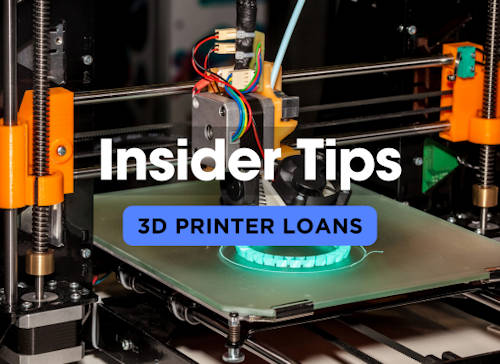3D printing technology has rapidly evolved, becoming an essential tool for businesses across various industries. Whether you’re in manufacturing, design, healthcare, or education, investing in a 3D printer can significantly enhance your operations. However, these machines come with a hefty price tag, making it crucial to explore financing options. A business loan tailored for purchasing a 3D printer can be a strategic investment, enabling you to leverage the technology’s capabilities while managing cash flow effectively. In this guide, we’ll dive into how a 3D printer can benefit your business and insider tips to secure a loan for that new 3d printer.
| IncBook: How a 3D Printer Can Benefit a Business | |
|---|---|
| Benefit | Explanation |
| Cost Reduction in Prototyping | 3D printing allows businesses to create prototypes rapidly and at a fraction of the cost compared to traditional manufacturing methods. This can significantly reduce the expenses associated with product development and iteration. |
| Customization and Personalization | Businesses can offer highly customized products to their customers, catering to specific needs and preferences. This level of personalization can create a unique selling proposition and enhance customer satisfaction. |
| Faster Time to Market | By enabling rapid prototyping and small-scale production, 3D printing can shorten the time it takes to bring a product from concept to market. This agility can provide a competitive advantage in fast-paced industries. |
| Reduced Inventory Costs | 3D printing on demand reduces the need for large inventories. Businesses can produce items as needed, minimizing storage costs and the risk of unsold products. |
| Innovation and Experimentation | The lower costs and increased speed of 3D printing allow businesses to experiment with new ideas and innovate without the financial risk associated with traditional manufacturing. This fosters a culture of creativity and continuous improvement. |
| Sustainability | 3D printing often uses less material and generates less waste than traditional manufacturing processes. This can help businesses reduce their environmental footprint and align with sustainability goals. |
| Access to New Markets | With the ability to produce specialized parts and products, businesses can tap into niche markets that were previously inaccessible due to the limitations of traditional manufacturing methods. |
| Enhanced Design Capabilities | 3D printing allows for complex geometries and designs that would be impossible or prohibitively expensive with traditional methods. This opens up new possibilities in product design and engineering. |
| Cost-Effective Small Batch Production | For businesses that require small quantities of products, 3D printing can be more cost-effective than mass production methods. It eliminates the need for expensive molds and setups, making it ideal for limited runs. |
| Improved Supply Chain Resilience | By producing parts and products in-house, businesses can reduce dependency on external suppliers, enhancing supply chain resilience and reducing lead times. |
Insider Tips
When it comes to securing a business loan specifically for purchasing a 3D printer, the process can be quite nuanced. Given the unique nature of this investment, lenders may require specific information and strategies to increase your chances of approval. Here are some insider tips that can set you apart from other applicants:
1. Highlight Industry-Specific Applications
- Detail Industry Use Cases: When applying for a loan, make sure to showcase how the 3D printer will be used within your specific industry. For instance, if you’re in manufacturing, highlight the rapid prototyping capabilities. If you’re in healthcare, emphasize how 3D printing can create custom medical devices or prosthetics. Tailoring your loan application to your industry demonstrates that you’ve thoroughly thought out the investment and its potential return.
- Provide Market Research: Include data or case studies showing how businesses in your industry have successfully integrated 3D printing. This can reassure lenders that the technology is a proven asset in your field.
2. Emphasize Cost Savings and ROI
- Present Detailed Cost-Benefit Analysis: Break down the cost savings you expect from using a 3D printer, such as reduced prototyping costs, lower inventory needs, and faster time to market. Calculate the expected return on investment (ROI) over a specific period and present these figures to your lender. A strong financial case can increase your chances of securing the loan.
- Showcase Previous Success: If you’ve already implemented 3D printing in your business in a limited capacity, highlight the financial impact it has had. If not, consider referencing similar businesses that have benefited financially from 3D printing.
3. Leverage Manufacturer Financing Partnerships
- Explore Manufacturer-Sponsored Loans: Some 3D printer manufacturers partner with financial institutions to offer specialized financing programs for their products. These programs often come with favorable terms, such as lower interest rates or extended repayment periods, as the manufacturer has a vested interest in selling their equipment. Research and reach out to manufacturers to see if such programs are available.
- Bundle Equipment and Software Financing: Often, 3D printing requires not just the printer but also specialized software and possibly additional equipment (e.g., post-processing tools). Some manufacturers offer financing bundles that cover everything you need, simplifying the loan process and ensuring you have all the tools required to maximize the printer’s utility.
4. Utilize Government and Industry Grants
- Investigate Grant Opportunities: Depending on your industry, there may be government or industry grants available for businesses adopting advanced manufacturing technologies like 3D printing. These grants can supplement your loan or even reduce the amount you need to borrow. Be sure to research both federal and state-level grants, as well as industry-specific programs.
- Incorporate Grants into Loan Negotiations: If you’ve secured a grant, inform your lender, as this reduces the risk from their perspective. A grant can serve as additional security for the loan, potentially leading to more favorable terms.
5. Tailor Your Loan Application for Technology Financing
- Engage Lenders Who Specialize in Technology Financing: Some lenders specialize in financing technology investments and are more familiar with the benefits and risks associated with 3D printing. These lenders might offer better terms or be more willing to approve a loan for 3D printing equipment.
- Include Technical Documentation: Provide detailed technical information about the 3D printer, including its capabilities, industry certifications, and how it compares to other technology on the market. Demonstrating your deep understanding of the equipment can build lender confidence.
6. Consider Lease-to-Own or Financing Options
- Explore Lease-to-Own Financing: Instead of a traditional loan, some businesses find lease-to-own financing for 3D printers more advantageous. This option allows you to lease the printer with the option to purchase it at the end of the lease term. It often requires less upfront capital and can be easier to qualify for.
- Negotiate End-of-Term Options: If pursuing lease-to-own, ensure you have clear and favorable terms for purchasing the equipment at the end of the lease. Also, look into whether there are options to upgrade the printer during the lease term, which can keep your technology current without needing a new loan.
7. Leverage Your 3D Printing Expertise
- Highlight Your Team’s Expertise: If your team has significant experience or certifications in 3D printing technology, be sure to emphasize this in your loan application. A skilled team reduces the risk of investment, as they are more likely to fully utilize the equipment’s capabilities.
- Include a Technology Utilization Plan: Outline a plan detailing how your business will integrate the 3D printer into existing operations, including staff training, workflow changes, and anticipated outcomes. A clear plan demonstrates preparedness and can instill confidence in your lender.
8. Showcase Green Initiatives
- Promote Sustainability Benefits: 3D printing is often associated with reduced material waste and energy efficiency. If your business is aiming to reduce its environmental footprint, highlight how the 3D printer will help you achieve these goals. Some lenders may offer better terms for environmentally friendly projects.
- Seek Green Financing Programs: Look for loans or financing options specifically targeted at sustainable or green initiatives. Some financial institutions provide incentives for businesses adopting technologies that reduce their environmental impact.
These insider tips are tailored to help you secure the best possible loan for a 3D printer, ensuring that you’re well-prepared and positioned for success in your business endeavors. By leveraging industry-specific knowledge, financial insights, and strategic lender engagement, you can make a compelling case for why investing in a 3D printer is a smart and necessary move for your business.



